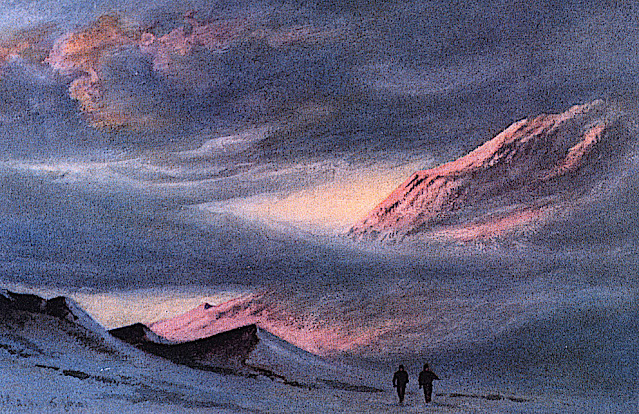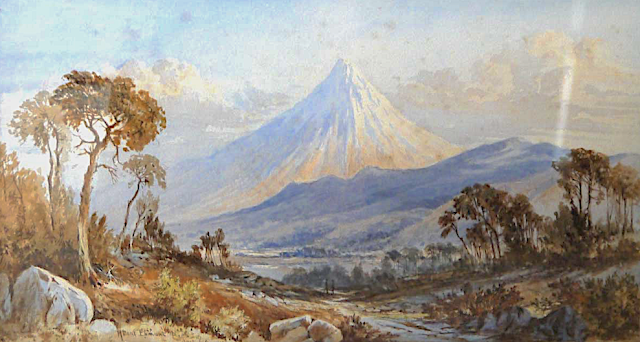EDWARD ADRIAN WILSON (1872-1912),
Mont Kirkpatrick (4 528 m)
Antarctique (Ross)
In Mount Patrick, croquis au crayon, 1911
La montagne
Le mont Kirkpatrick (4 528 m) est le point culminant du chaînon de la Reine-Alexandra, en Antarctique. Situé à 8 kilomètres à l'ouest du mont Dickerson, le mont Kirkpatrick est le point culminant de la chaîne Transantarctique. Découvert et nommé par l'expédition Nimrod en 1908-1909, la montagne doit son nom à un homme d'affaires de Glasgow, qui était l'un des sponsors de l'expédition. Sur les pentes du mont Kirkpatrick se trouve l'un des plus importants sites paléontologiques de l'Antarctique : la formation de Hanson, datée du Jurassique inférieur. À cette période, l'Antarctique était plus chaud et faisait partie du supercontinent nommé Pangée, ainsi les fossiles trouvés sur le site peuvent être retrouvés ailleurs dans le monde. À plus de 4 000 mètres d'altitude, des restes fossiles de vertébrés y ont été découverts, dont ceux du premier dinosaure trouvé sur le continent, Cryolophosaurus ellioti, nommé en 1994. Une autre espèce de dinosaures, Glacialisaurus hammeri, a été découverte durant une campagne de recherche en 2003-2004. Ce site a également livré les restes d'un cynodonte de la famille des tritylodontidés et un humérus de ptérosaure.
L'artiste
Edward Adrian Wilson,
surnommé « Oncle Bill » était un médecin anglais, explorateur polaire,
historien naturel, peintre et ornithologue. Wilson a participé à deux
expéditions britanniques en Antarctique, la Discovery Expedition
(1901-1904) et la tragique expédition Terra Nova (1907-1912), toutes
deux sous la direction de Scott.
Le Dr Edward A. Wilson est -
considéré comme l’un des meilleurs artistes ayant jamais travaillé en
Antarctique. Naviguant avec le capitaine Scott à bord du « Discovery »
(1901-1904), il est devenu le dernier d'une longue tradition d'«
artistes d'exploration » d'une époque où le crayon et l'aquarelle
étaient les principales méthodes permettant de produire des
enregistrements scientifiques précis de nouvelles terres et d'espèces
animalières. Il a combiné des techniques scientifiques, topographiques
et paysagères pour produire des images précises et magnifiques du
dernier continent inconnu. La force de son œuvre fut telle qu’elle
contribua également à fonder la tradition de la peinture animalière
moderne. Wilson a notamment capturé sur papier l’essence du vol et du
mouvement des oiseaux marins de l’océan Austral.
De retour avec le
capitaine Scott à bord du « Terra Nova » (1910-1913) en tant que chef du
personnel scientifique, il a continué à decrire le continent et sa
faune avec une habileté extraordinaire. Choisi pour accompagner le
capitaine Scott au pôle Sud, ses derniers dessins sont issus de l'un des
voyages épiques les plus célèbres de l'histoire de l'exploration.
Parallèlement à son travail scientifique, le crayon de Wilson a capturé
la découverte de la tente de Roald Amundsen au pôle Sud par le capitaine
Scott. Wilson mourut, avec les autres membres du British Pole Party,
pendant le voyage de retour, en mars 1912. Les dessins et les peintures
furent créés au prix d'un travail personnel considérable dans les
conditions glaciales dans lesquelles Wilson travaillait. Il souffrait
souvent gravement du froid lorsqu'il dessinait, ainsi que de la cécité
des neiges ou de coups de soleil aux yeux. Ils constituent un
remarquable témoignage de l’une des grandes figures de l’époque héroïque
de l’exploration de l’Antarctique. Le livre a été produit en complément
des « Carnets de la nature d'Edward Wilson » par deux des petits-neveux de Wilson, pour marquer le centenaire de sa mort.
______________________________________
2025 - Gravir les montagnes en peinture
Un blog de Francis Rousseau
-%20%20Mount-Patrick-%20Dec%2016th%201911.jpg)
%20-%20Les%20dentelles%20de%20Montmirail%20et%20la%20mance%20Mountains,_South_of_France,_1910,_.jpg)
%20-%20%20Mitre%20Peak:%20Rahotu%20%20Milford%20Sounds-%20Watercolour%20for%20Arts%20Series%20postcard%20board-%20%20NEw%20Zealand%20Posycard%20Society%20.png)




-%20Milford%20Sound%20with%20Mount%20Pembroke%20Peak%20and%20Mitre%20Peak:rahotu%20,%201901%20watercolor%20on%20Bristol%20board-%20South%20Coast%20Antiques%20&%20Gallery.jpg)

-Mount%20Amstead,%20Rees%20River,%20%20Matukituki%20River,%20Watercolour-%20Christchurh%20Art%20GAllery-%20Te%20Puna%20o%20Waiwhetu.%20jpg.jpg)









